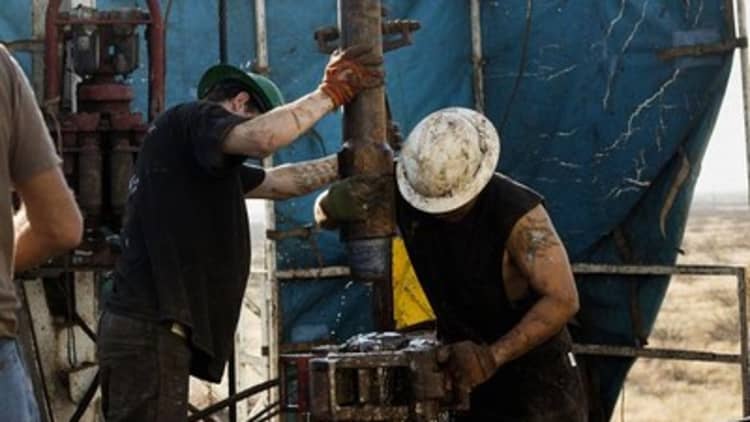Hydraulic fracturing was most likely the cause of an unusually strong earthquake in Ohio, according to a new study from researchers at Miami University of Ohio.

The new study, published online in the Bulletin of the Seismological Society of America on Monday, says that a 3.0-magnitude quake—the biggest in a series of several—that rattled the area of Poland Township in March 2014 was linked to drilling and "fracking" activity at one of several local hydraulic fracturing wells.
Researchers pointed out that such a magnitude quake is minor when compared with some of the more serious quakes that hit regions such as California and Japan.
"It would be similar to a truck driving by your house," said Robert Skoumal, who co-authored the paper, in an email to CNBC. But even a 3.0 is unusual for the Ohio, and it's certainly one of the biggest of several earthquakes attributed to fracking, he said.
Read MoreOil will hit bottom soon: Analyst
But the quake was big enough to catch the attention of the Ohio Department of Natural Resources, a government agency that regulates gas and oil extraction in the state. The agency subsequently told energy exploration company Hilcorp to halt drilling a new well close to the earthquake's epicenter—one of six wells the company has in the area.
The moratorium is still in effect, ODNR spokeswoman Bethany McCorkle told CNBC, but Hilcorp is allowed to pump out of wells it has already drilled.
Hilcorp representatives said they wanted to review the full report before commenting.
"These events are extremely rare and more often attributed to geothermal heating, dam impoundments and mining operations," Shawn Bennett, executive vice president of the Ohio Oil and Gas Association, a local energy trade group, said in an email to CNBC. "However, the Ohio Oil and Gas Association and the broader oil and gas industry understands the importance of such events and is looking at induced seismicity across the nation."
The association said it's working with regulators and experts on the issue.
Skoumal and his colleagues are confident their study confirms the earthquake was induced by fracking, which is a process that involves recovering gas or oil by injecting huge amounts of water underground at high pressure.
The researchers used an uncommon technique for measuring seismic activity called "template matching" that enables them to identify earthquakes much smaller than those detected by traditional methods, Skoumal said.

Earthquakes produce seismic patterns that are like fingerprints, Skoumal said. Natural seismic activity follows different patterns—and thus has a different fingerprint—from induced seismic activity.
When a quake occurs, researchers measure that quake's seismic patterns against many others in a database, and look for other quakes whose patterns match. Those matches give a clearer idea of what is going on seismically, said Skoumal, allowing researchers to determine whether a quake was actually caused by fracking-related activity, or if it was just a natural quake that occurred coincidentally near a well.
One of the crucial differences between natural earthquakes and induced ones is the patterns they follow. A natural earthquake series usually begins with a big shock and then one or several aftershocks. Induced earthquakes have more of a "swarm-like" pattern, and large shocks will often follow smaller ones. In Poland Township, the magnitude 3.0 quake came near the end of a series of quakes.
Another difference is the sheer number of earthquakes in a given period of time. Researchers identified 77 matching earthquakes around Poland Township from March 4 to March 12—an unnatural number, said Skoumal. One would expect to see no more than two natural quakes in the same period of time.
Read MoreAs oil breaks $50, Wall Street getting more bearish
The largest earthquake to hit Ohio since 2010 was a 4.0 magnitude quake in Youngstown in 2011. Skoumal and his colleagues linked that one to wastewater injection—a process where water left over from fracking is injected into wells in the ground.
Skoumal said that wastewater injection may be a bigger concern than fracking itself—over the past decade, injection wells have been linked to more earthquakes, and many of higher magnitudes.
How fracking activity exactly may have caused the quake is still a bit of a mystery. The researchers identified the responsible fault in a layer of rock called the precambrian basement—but drills did not dig that far into the rock, so they could not have hit it directly.
Read MoreThis is a ticking time bomb for stocks
Skoumal and colleagues have two theories. One is that fluids from fracking operations seeped into the fault, causing a slip. Skoumal also thinks the quake could have resulted from "dynamic stressing." It is not easy to explain, he said, but basically an activity such as fracking could trigger certain "stresses" in rock, if it is close enough to a fault.

Oklahoma and, more recently, Kansas have both seen jumps in seismic activity, and it is "very likely" these earthquakes are caused by both fracking and wastewater injection, Skoumal said. Even still, earthquakes from fracking are rare and the seismic hazard posed by fracking is likely to be minimal, he added.
Skoumal also noted that Ohio has been "especially proactive" in addressing induced seismicity, compared with other states.
"People should not panic about induced seismicity if there is a well nearby, but I think they should become informed on the issue," Skoumal said.


